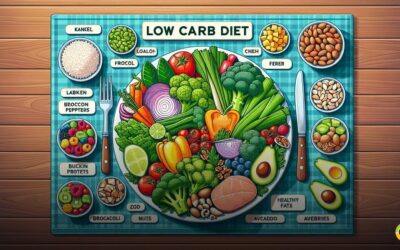If you’ve been on a weight loss journey, you may have encountered the frustrating experience of hitting a plateau. These plateaus can be challenging to overcome, but with the right strategies, you can break through and continue making progress towards your goals. In this article, we will discuss proven strategies to overcome weight loss plateaus, including understanding why they occur, revamping your diet for optimal metabolism, incorporating high-intensity interval training to boost fat loss, and the role of sleep and stress management in conquering plateaus.
Contents
Understanding Weight Loss Plateaus and Why They Occur
Weight loss plateaus are a common occurrence during a weight loss journey, where individuals experience a stall in their weight despite continued efforts. These plateaus can be frustrating and demotivating, but understanding why they occur can help individuals navigate through them effectively.
One of the reasons for weight loss plateaus is the body’s natural adaptation to a lower calorie intake. When individuals reduce their calorie consumption to lose weight, the body adjusts its metabolism to function on fewer calories, leading to a slowdown in weight loss progress.
Another factor contributing to weight loss plateaus is the lack of variety in the diet and exercise routine. The body may adapt to a consistent diet and exercise regimen, making it more challenging to continue losing weight.
Additionally, hormonal changes, stress, inadequate sleep, and other lifestyle factors can also play a role in causing weight loss plateaus.
Understanding these reasons can help individuals make necessary adjustments to overcome plateaus and continue making progress towards their weight loss goals.
Revamping Your Diet for Optimal Metabolism
Revamping your diet is crucial for optimizing your metabolism and breaking through weight loss plateaus. By making strategic changes to your eating habits, you can kickstart your body’s fat-burning process and achieve your fitness goals.
When revamping your diet, focus on incorporating nutrient-dense foods that support metabolism, such as lean proteins, leafy greens, whole grains, and healthy fats. These foods provide essential nutrients that aid in energy production and metabolic function.
Additionally, consider the timing of your meals. Eating smaller, well-balanced meals throughout the day can help maintain stable blood sugar levels and prevent metabolic slowdown. Avoiding long periods of fasting can also keep your metabolism active.
Hydration is another key factor in optimizing metabolism. Drinking an adequate amount of water supports cellular function and can enhance the body’s ability to burn fat efficiently.
Furthermore, be mindful of your calorie intake. While it’s important to create a calorie deficit for weight loss, excessively low-calorie diets can actually slow down metabolism. Aim for a moderate and sustainable calorie reduction to support metabolic rate.
Finally, consider consulting with a nutritionist or dietitian to create a personalized meal plan that aligns with your metabolic needs and weight loss goals. A professional can provide tailored guidance to ensure that your revamped diet is optimized for metabolic efficiency.
Incorporating High-Intensity Interval Training to Boost Fat Loss
High-Intensity Interval Training (HIIT) has gained popularity for its effectiveness in boosting fat loss. Incorporating HIIT into your fitness routine can help break through weight loss plateaus and accelerate fat burning.
What is HIIT?
HIIT involves short bursts of intense exercise followed by brief periods of rest or low-intensity activity. This type of training increases the body’s need for oxygen during exercise and creates an oxygen shortage, causing the body to adapt and increase its oxygen intake. As a result, the body continues to burn calories at a higher rate even after the workout is completed.
Benefits of HIIT
-
- Efficient fat burning: HIIT workouts are known to burn more fat in less time compared to steady-state cardio.
-
- Increased metabolism: HIIT can boost your metabolism, leading to continued calorie burn even after the workout.
-
- Preservation of muscle mass: HIIT can help preserve muscle while promoting fat loss, unlike traditional steady-state cardio which may lead to muscle loss.
-
- Time-saving: HIIT workouts are typically shorter in duration, making them a convenient option for individuals with busy schedules.
How to Incorporate HIIT
HIIT can be incorporated into various forms of exercise, including running, cycling, bodyweight exercises, and more. A typical HIIT session may involve 20-30 seconds of high-intensity exercise followed by 10-15 seconds of rest or low-intensity activity, repeated for several cycles.
Considerations
It’s important to start HIIT gradually, especially for beginners, to allow the body to adapt to the intensity. Consulting with a fitness professional or trainer can help in designing a safe and effective HIIT program tailored to individual fitness levels and goals.
Incorporating HIIT into your fitness regimen can be a valuable strategy for overcoming weight loss plateaus and achieving your fat loss goals.
The Role of Sleep and Stress Management in Conquering Plateaus
When it comes to conquering weight loss plateaus, the role of sleep and stress management should not be underestimated. Both factors play a crucial role in the body’s ability to lose weight effectively.
Sleep: Adequate and quality sleep is essential for overall health and well-being. Lack of sleep can disrupt hormonal balance, leading to increased stress levels and imbalanced appetite regulation. This can ultimately hinder weight loss progress.
Stress Management: Chronic stress can lead to elevated levels of cortisol, a hormone that is associated with weight gain, particularly in the abdominal area. Managing stress through relaxation techniques, mindfulness, and regular physical activity can help lower cortisol levels and support weight loss efforts.
By prioritizing sufficient sleep and implementing effective stress management strategies, individuals can optimize their body’s ability to overcome weight loss plateaus and achieve their desired fitness goals.










0 Comments